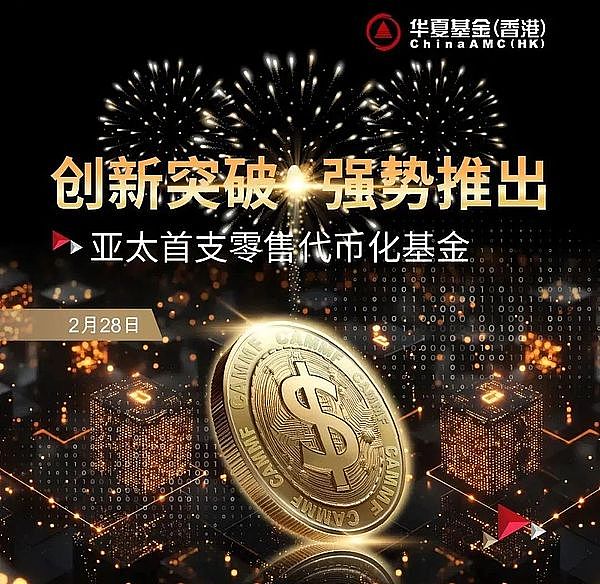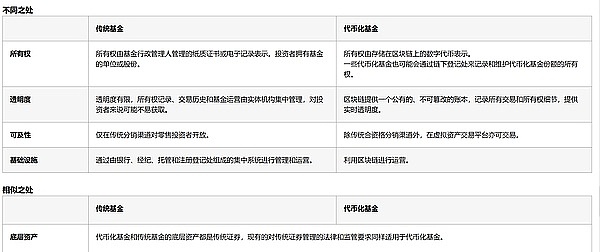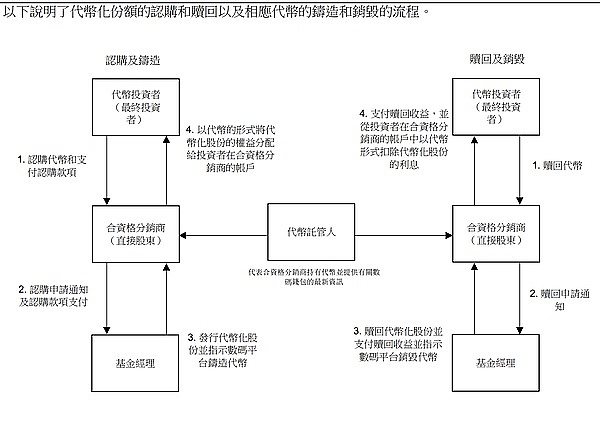This fund is the first retail fund approved in Hong Kong, China since the release of the circular "Tokenized SFC-approved Investment Products" in November 2023, marking a key breakthrough for tokenized assets from institutional exclusive to the mass market. Currently, the official website announcement of China Asset Management (Hong Kong) shows that the "China Asset Management Hong Kong Dollar Digital Currency Fund" has been issued as scheduled on February 28, 2025.

Traditional money market funds are easier to understand, but what are tokenized funds? How are they different from traditional funds? Which investors can subscribe, and how can they subscribe and redeem? What are the investment assets of the first tokenized fund for the general public in Asia Pacific? As a professional lawyer team that continuously tracks the latest developments in the global Web3 and cryptocurrency fields, Crypto Salad will combine other tokenized fund examples around the world to sort out and disassemble the above questions for everyone.
1. What is a tokenized fund? What is the difference between it and a traditional fund?
The so-called tokenization refers to the process of converting the rights and interests of real-world assets (RWAs) into digital tokens on the blockchain, and tokenized funds are to "chain" fund shares as underlying assets into digital tokens. The ownership of the fund is represented by the token, and one token (or part of it) represents a unit or share (or part of it) of the fund.
Therefore, the essence of fund tokenization is to convert fund shares into on-chain certificates and then issue them. For example, the BUIDL tokenized fund launched by BlackRock in 2024 adopts the USD/USDC subscription mechanism, with the tokens and fund shares strictly anchored at 1:1, and automated conversion is achieved through smart contracts, investing in USD cash reserves, short-term US Treasury bonds, and high-quality money market instruments (such as bank certificates of deposit, high-rated commercial paper, etc.).
In fact, from the perspective of the essence of investment, there is no obvious difference between tokenized funds and traditional funds. However, since tokenized funds are built on the basis of blockchain technology innovation, they have many innovations in ownership, information transparency and transaction models:

(Comparison chart of the two by China Asset Management)
2. What is special about the "China Asset Management Hong Kong Dollar Digital Currency Fund"? How do investors apply for redemption?
In fact, there is no essential difference between the investment assets of the "China Asset Management Hong Kong Dollar Digital Currency Fund" and traditional money market funds. According to the "Product Information Summary" of the fund, its main investment assets are Hong Kong dollar short-term deposits and high-quality money market instruments, and other money market instruments and money market funds are used as auxiliary investment assets. At the same time, the fund also provides three share categories for investors to choose from: Hong Kong dollars, US dollars and RMB.
However, as the first tokenized fund for retail investors in the Asia-Pacific region, its core feature is the special issuance method of "tokenization". From the perspective of the tokenization model, the fund adopts a custodial tokenization model, with Standard Chartered Bank (Hong Kong) acting as a tokenization agent, digital platform operator and token custodian, and completing the technical implementation through the internal authorized digital platform created by its wholly-owned subsidiary Libeara.
At the same time, due to the difference in fund forms, investors' subscription and redemption channels and methods will also be different from traditional funds. First of all, it should be noted that the "Product Information Summary" emphasizes that retail investors can only subscribe or redeem tokenized shares in the form of tokens through qualified distributors. Currently, the only "qualified distributor" officially disclosed by China Asset Management is OSL Digital Securities Co., Ltd., which is also the only listed and licensed cryptocurrency trading platform in Hong Kong. Specifically, investors can only subscribe to the fund tokens on the chain through qualified distributors, namely OSL Exchange, and after the subscription, the fund shares will be converted into corresponding tokenized shares and will be managed by SCB (Standard Chartered Bank).
Secondly, regarding the scope of investors targeted by the fund. The articles of association of the company corresponding to the sub-fund clearly state that the fund is only issued to investors in Hong Kong and is not sold in any other countries or regions. Therefore, investors in mainland China cannot directly participate in the subscription and redemption of the fund.
Third, what mechanism does the tokenized fund use to achieve the subscription and redemption of tokens?
Due to the difference in product structure, the subscription and redemption mechanism of the tokenized fund and the traditional fund are also very different.

(Huaxia Fund's official graphic introduction to the subscription and redemption mechanism of the fund)
Subscription (legal currency → token):
Process: The final investor subscribes to the fund token through the channels of qualified distributors and confirms the payment of the subscription amount with legal currency. The Qualified Distributor notifies the Fund Manager of the subscription application and pays the subscription amount of the final investor to the Fund Manager. After receiving the subscription application, the Fund Manager will issue the corresponding tokenized shares and instruct the blockchain digital platform to mint the tokens. After the tokens are minted, the token custodian will keep them in the blockchain wallet of the Qualified Distributor on behalf of its final investors. Finally, the Qualified Distributor will distribute the rights of the tokenized shares to the investment in the form of tokens.
Redemption (tokens → legal currency):
Process: The final investor redeems the fund tokens from the Qualified Distributor, and the Qualified Distributor issues a redemption application notice to the Fund Manager. After receiving the redemption notice, the Fund Manager will redeem the tokenized shares and instruct the blockchain digital platform to destroy the corresponding tokens, and pay the redemption proceeds to the Qualified Distributor. Finally, the Qualified Distributor will pay the redemption proceeds to the final investor and deduct the tokens that the investor has custodied in the Qualified Distributor's wallet.
In addition to the "Huaxia Hong Kong Dollar Digital Currency Fund", other global tokenized funds also have their own unique subscription and redemption mechanisms. Taking BUIDL as an example, the two-way 1:1 anchoring of its fund shares and on-chain certificates (tokens) is achieved in the following way:
Subscription (fiat currency/stable currency→token):
Process:Investors transfer USD/USDC to a designated escrow account (off-chain bank account or on-chain smart contract). After the system verifies that the funds have arrived, the smart contract automatically casts an equal amount of BUIDL tokens and sends them to the investor's whitelist address.
Subscription method: Investors can subscribe directly through the blockchain after passing the KYC/AML review and use a compliant digital wallet to complete the on-chain transaction; they can also subscribe in cash through banks or securities firms, and the fund manager will tokenize and allocate it to the on-chain wallet.
Redemption (tokens → legal currency/stable currency):
Process:Investors send BUIDL tokens to the designated redemption address. After the smart contract destroys the tokens, the custodian bank transfers the equivalent amount of USD/USDC to the investor's account according to the instructions. Redemption can be completed in two ways:
1. Off-chain settlement: initiated through the Securitize platform, and the funds are received within T+0 working days;
2. On-chain atomic settlement: real-time exchange to USDC through the Circle liquidity pool (only for the token part, undivided dividend income needs to be handled separately).
Income calculation:Income is recorded every working day according to the shares held by the address, and income is distributed on the first working day of each month by issuing additional BUIDL tokens and airdropping.
Fourth, Crypto Salad Review
As the first retail tokenized fund approved in Asia-Pacific, Huaxia’s tokenized fund is a milestone breakthrough for the application of Web3.0 and blockchain technology. The Crypto Salad team believes that this event marks that the application technology of the Web3.0 era has entered a new stage and officially opened the door to participation to the general public investors. Although the underlying assets of its current investment are low-risk money market funds, official documents also indicate that this attempt to tokenize funds for the general public focuses on the innovation and advancement of RWA (real world assets) and blockchain technology, and pays more attention to the security and high liquidity of assets, rather than the investment orientation of high risk and high return. Therefore, for the establishment of the ecosystem of the tokenized fund market in Hong Kong, this issuance is only the first step, and the overall attitude is relatively cautious. However, the Crypto Salad team believes that if this attempt can be successfully run, it is very likely that more funds will embark on the road of blockchain tokenization in the future, and more investment strategies can also be expected. For example, in addition to the legal currency trading method, is it possible to achieve all-weather instant trading through digital currency? Although it is currently only a cash product, is it possible for future tokenized funds to further expand their investment assets and launch products with higher returns?
As the compliant blockchain currency system gradually matures, asset tokenization, with its advantages in on-chain transactions and global liquidity, may become the core driving force for reshaping the global asset management landscape.
 Catherine
Catherine
 Catherine
Catherine Kikyo
Kikyo Alex
Alex Catherine
Catherine Miyuki
Miyuki Weiliang
Weiliang Alex
Alex Miyuki
Miyuki Kikyo
Kikyo Kikyo
Kikyo